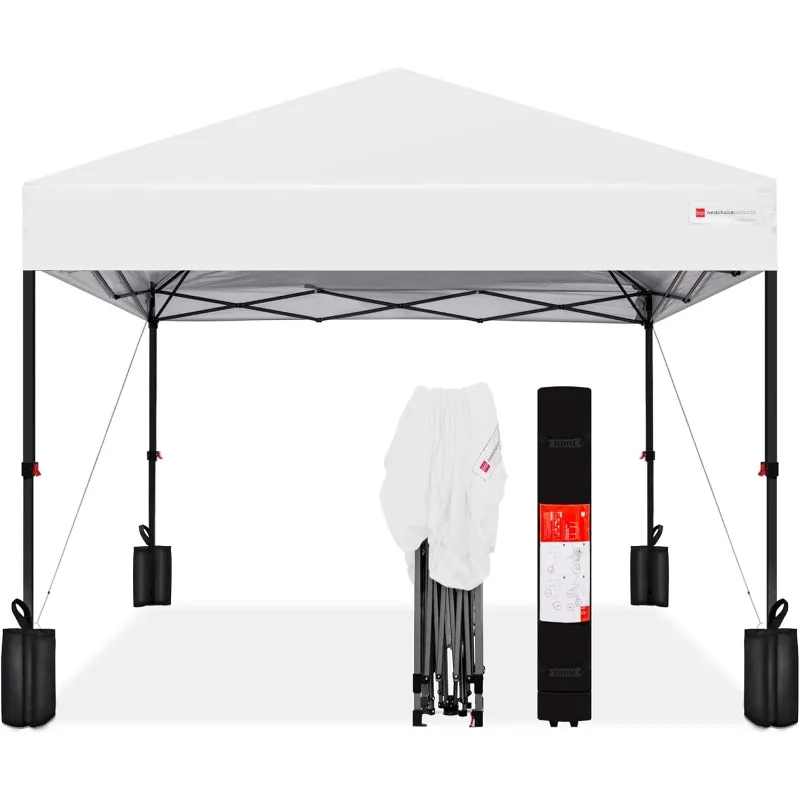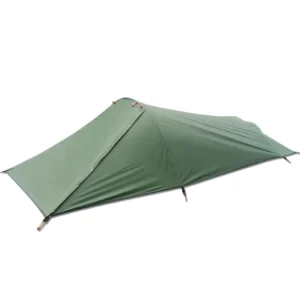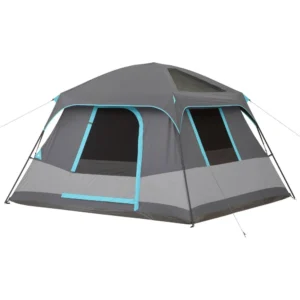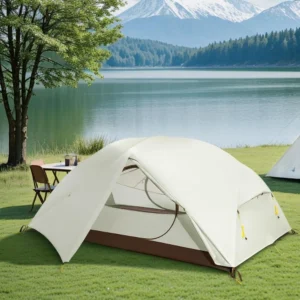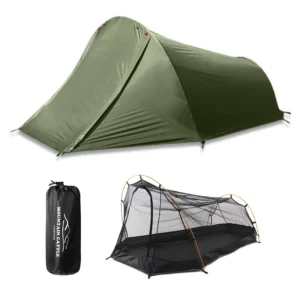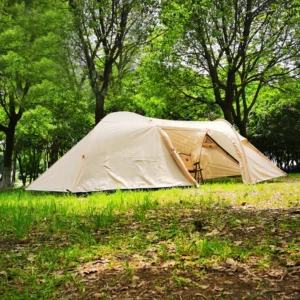Why Two-Person Dome Tents Stand Out in the Camping World
A two-person dome tent is a shelter characterized by its curved, hemispherical shape created by flexible poles that cross at the top and bend to the ground. This distinctive design has made dome tents one of the most popular choices among campers of all experience levels, striking an impressive balance between interior space, portability, and structural stability.
The key value proposition of two-person dome tents lies in their versatility. With typical floor dimensions offering 30-35 square feet (2.8-3.2 square meters) of space and weighing between 4-6 pounds (1.8-2.7 kg) for backpacking models, these tents provide sufficient room for two adults while remaining manageable to transport. This makes them suitable for everything from car camping to multi-day backpacking adventures.
What truly sets these tents apart is how they combine several critical advantages: excellent stability in adverse weather, intuitive setup, efficient use of space, and impressive durability. These benefits make dome tents accessible to beginners while still meeting the expectations of seasoned outdoor enthusiasts.
When compared to other tent styles like tunnel or cabin tents, two-person dome tents occupy a sweet spot in the market, offering superior storm resistance than many cabin models while providing better headroom than traditional A-frame designs. The comprehensive ultimate guide to dome tents for two people provides deeper insights into how these shelters have evolved to meet diverse camping needs.
Understanding the dome tent structure is key to appreciating why these tents continue to dominate the camping landscape, combining time-tested design principles with modern materials and manufacturing techniques.
Superior Stability in Challenging Weather Conditions
The exceptional stability of two-person dome tents in rough weather conditions is directly related to their unique structural design. The intersecting poles create a self-supporting framework that distributes force evenly throughout the tent, allowing it to withstand significant pressure from different directions.
Unlike many other tent designs, dome tents excel in wind resistance due to several key factors:
- The curved shape allows wind to flow around the structure rather than creating flat surfaces that catch the wind
- The flexibility of the poles absorbs force instead of fighting against it
- The low-profile aerodynamic design reduces wind resistance, particularly when oriented properly
- Multiple anchor points distribute tension evenly across the entire structure
Quality two-person dome tents can typically withstand winds of 30-40 mph (48-64 kph) without significant deformation, with premium models using geodesic or semi-geodesic designs capable of handling even stronger gusts. These more advanced designs incorporate additional pole crossings to create triangular sections that further enhance structural integrity.
Pole material plays a crucial role in stability as well. Aluminum poles provide the optimal balance of strength and weight, while fiberglass options, though more affordable, offer less durability in extreme conditions. The most demanding environments call for specialized aluminum alloys that maximize strength-to-weight ratio.
When it comes to rain and snow, the dome shape naturally prevents precipitation accumulation, allowing water and snow to slide off rather than pooling on top. This advantage becomes particularly apparent when comparing dome tents to cabin-style options that feature flat roof sections prone to collecting water.
For campers seeking reliable protection in variable conditions, understanding dome tent shapes and stability can help in selecting the ideal configuration. Our collection of dome camping tents includes options specifically engineered to maximize stability in challenging environments.
Quick and Intuitive Setup Process
One of the most practical advantages of two-person dome tents is their remarkably straightforward setup process. Most models can be fully assembled in just 5-10 minutes, even by a single person with minimal experience. This efficiency stems from a logical design that eliminates many of the complexities found in other tent styles.
The typical setup process follows these simple steps:
- Lay out the tent body flat on the ground
- Assemble the poles (most use shock-corded sections that snap together)
- Insert the poles through sleeves or attach them to clips on the tent body
- Secure the pole ends into grommets at the tent corners
- Attach the rainfly over the tent body if needed
- Stake out the corners and guy lines for added stability
Modern two-person dome tents often feature color-coded poles and attachment points, virtually eliminating the guesswork. The clip-attachment systems found on most contemporary models offer significant advantages over older sleeve designs, allowing for faster setup and improved ventilation between the tent body and rainfly.
Perhaps the most significant setup advantage is the freestanding nature of dome tents. Once the basic structure is assembled, the entire tent can be picked up and repositioned to find the optimal spot before staking. This feature is especially valuable when camping on terrain with rocks or roots that might otherwise interfere with stake placement.
The dome design also adapts well to uneven ground, as the flexible structure can accommodate minor surface irregularities without compromising stability. Many campers find that comparing instant dome tents to traditional models helps identify which setup style best matches their priorities. For those placing absolute premium on convenience, our selection of easy-setup camping tents offers options that further streamline the process.
Versatility Across Different Camping Environments
Two-person dome tents truly excel in their adaptability to diverse camping environments. Whether you’re setting up in a dense forest, on an exposed beach, or on rocky alpine terrain, the dome structure provides consistent performance across varying conditions.
In forested areas, the compact footprint makes it easier to find suitable flat spots between trees and roots. On beaches and desert environments, the aerodynamic profile helps shed wind that would otherwise pummel flat-sided tent designs. Even in rocky mountain terrain with limited flat ground, the flexible structure can conform somewhat to minor surface irregularities without compromising comfort or stability.
Most two-person dome tents are designed as 3-season shelters, suitable for spring, summer, and fall conditions with temperature ranges from around 20°F to 90°F (-7°C to 32°C). They balance ventilation for warm conditions while providing adequate protection from rain and mild cold. Four-season variants, with stronger pole structures and more substantial fabrics, extend this range to handle winter conditions and snow loads.
The versatility extends to camping styles as well. These tents perform admirably for:
– Weekend car camping trips where setup simplicity matters
– Multi-day backpacking adventures requiring reliable weather protection
– Festival camping where space efficiency is crucial
– Remote backcountry expeditions demanding dependable shelter
Many quality models incorporate vestibules—covered exterior areas created by the rainfly—that add valuable protected space for gear storage and wet boot removal, enhancing functionality without increasing the tent’s footprint.
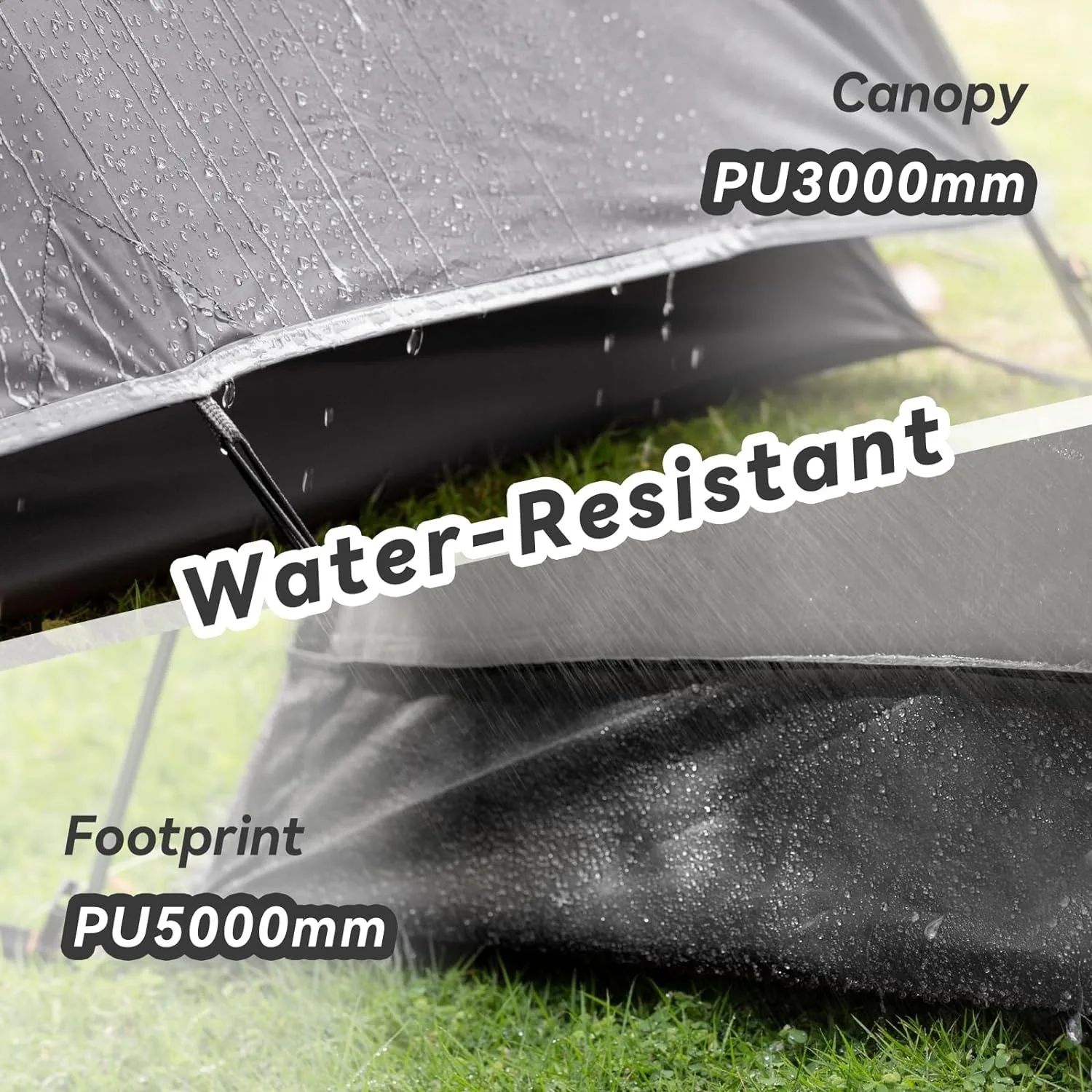
For hikers specifically, our guide to best 2-person dome tents for hiking provides targeted recommendations based on trail performance. Additionally, our collection of waterproof camping tents includes models specifically designed to handle challenging precipitation without compromising ventilation.
Efficient Space Utilization and Comfort
The dome structure creates a remarkably efficient living space that maximizes usability despite the tent’s compact footprint. Two-person dome tents typically offer 30-35 square feet (2.8-3.2 square meters) of floor space, but the curved walls and strategic pole placement create a volume that feels surprisingly spacious.
Peak height—typically ranging from 40-48 inches (102-122 cm)—is positioned centrally where it provides maximum benefit, allowing occupants to sit upright comfortably. This creates what tent designers call “livable space,” which reflects the actual usable volume rather than just raw dimensions. The dome shape provides more usable volume than many other tent designs with similar floor dimensions.
When comparing space utilization:
– Center height is maximized where most needed (middle of the tent)
– The curved walls create more shoulder room than sloped A-frame designs
– Two adults can typically sit facing each other without feeling cramped
– Gear storage pockets and overhead loops help organize smaller items
For two people sharing the space, the dome design offers several comfort advantages. The lack of center poles eliminates obstructions in the sleeping area, allowing for flexible sleeping arrangements. Many models feature dual doors and vestibules, reducing the need to climb over your camping partner for nighttime exits and providing each person dedicated storage space.
The question of whether a 2-person tent is actually big enough depends largely on individual preferences, but dome models generally offer the most efficient use of limited dimensions. The curved interior walls create more elbow room than many other designs, though taller campers (over 6 feet/183 cm) may want to verify the tent’s length before purchasing.
Modern designs often incorporate thoughtful details like asymmetrical floor plans that widen at the shoulders and taper at the feet, further optimizing the space without increasing the overall footprint.
Durability and Longevity Advantages
The inherent structural principles of dome tents contribute significantly to their durability and longevity. The curved shape distributes tension evenly across the tent fabric, reducing stress concentrations that lead to premature wear and tear. This even distribution means that no single area bears excessive load, extending the lifespan of both the fabric and structural components.
Quality materials further enhance these durability advantages:
– Ripstop nylon or polyester fabrics resist tearing and abrasion
– Silicone-treated nylon (silnylon) offers excellent strength-to-weight ratio and water resistance
– Floors in quality models typically feature 40-70 denier fabric with waterproof coatings
– Rainflies often utilize 20-40 denier fabric with UV protection treatments
Well-designed dome tents include reinforcement at critical stress points—pole insertion points, stake loops, and door zippers—preventing the most common failure points. The simplified pole structure compared to more complex tent designs means fewer components that could potentially fail, while the standardized poles are typically easier to repair or replace if damage does occur.
With proper care and maintenance, a quality two-person dome tent can last 5-10 years of regular use. More premium models may extend beyond this timeframe when properly maintained. The simple architecture also makes field repairs more manageable than with more complex tent designs.
The repair advantage becomes particularly valuable for remote camping where replacement isn’t an option. Most dome tent damage can be addressed with basic repair items: pole splints, seam sealer, repair tape, and patch kits.
Our 2-person camping tents collection features models designed with durability as a priority, using materials and construction methods that enhance longevity without excessive weight penalties.
Optimal Portability and Weight Distribution
For many campers, particularly those covering distance on foot, the weight and packability of a two-person dome tent represent crucial advantages. These tents strike an impressive balance between livable space and manageable weight, making them ideal for various camping styles.
Two-person dome tents generally fall into distinct weight categories:
– Ultralight models: 3-4 pounds (1.4-1.8 kg)
– Standard backpacking models: 4-6 pounds (1.8-2.7 kg)
– Comfort/durability focused models: 6-8 pounds (2.7-3.6 kg)
When packed, most two-person dome tents compress to approximately 18 x 6 inches (46 x 15 cm), fitting neatly into a backpack without consuming excessive space. The simple pole structure contributes to this compact packed size, as the poles can be broken down into short sections typically no longer than 20 inches (51 cm).
For backpacking couples or partners, dome tents offer excellent weight distribution possibilities. Common strategies include:
– One person carries the tent body and stakes while the other carries poles and rainfly
– One person carries the complete tent one day, then trades with their partner the next
– Splitting components between more than two packs for group trips
The weight-to-space ratio of dome tents is particularly favorable compared to other designs. While tunnel tents might offer slightly more interior volume for similar weight, they typically require more stakes and guy lines for proper setup. Ultralight alternatives like tarps may weigh less but sacrifice protection and ease of setup.
For those focused on minimizing pack weight, mastering tent packing tips can further optimize the carrying experience. Our selection of ultralight dome tents showcases options specifically engineered to minimize weight while maintaining essential functionality.
Enhanced Ventilation and Condensation Management
Proper ventilation is crucial when two people share a small enclosed space, as adult sleepers typically release about 1 liter of moisture through respiration and perspiration overnight. Two-person dome tents excel in managing this moisture challenge through thoughtful design features.
The double-wall construction—consisting of a breathable inner tent body and a waterproof rainfly—creates an effective system for moisture management:
– Water vapor passes through the breathable inner canopy
– The space between canopy and rainfly allows air circulation to remove moisture
– Strategically placed vents in the rainfly permit continued airflow even during rain
Quality dome tents feature multiple ventilation options that can be adjusted based on conditions:
– High and low vents create natural convection airflow
– Mesh panels in the upper tent body enhance air circulation while keeping insects out
– Vestibule vents reduce condensation in storage areas
– Door positioning allows for cross-ventilation when weather permits
This ventilation superiority becomes particularly apparent in challenging conditions where condensation is most problematic—cool nights after warm days or in humid environments. The dome structure naturally creates interior airflow patterns that help move moisture-laden air toward vents.
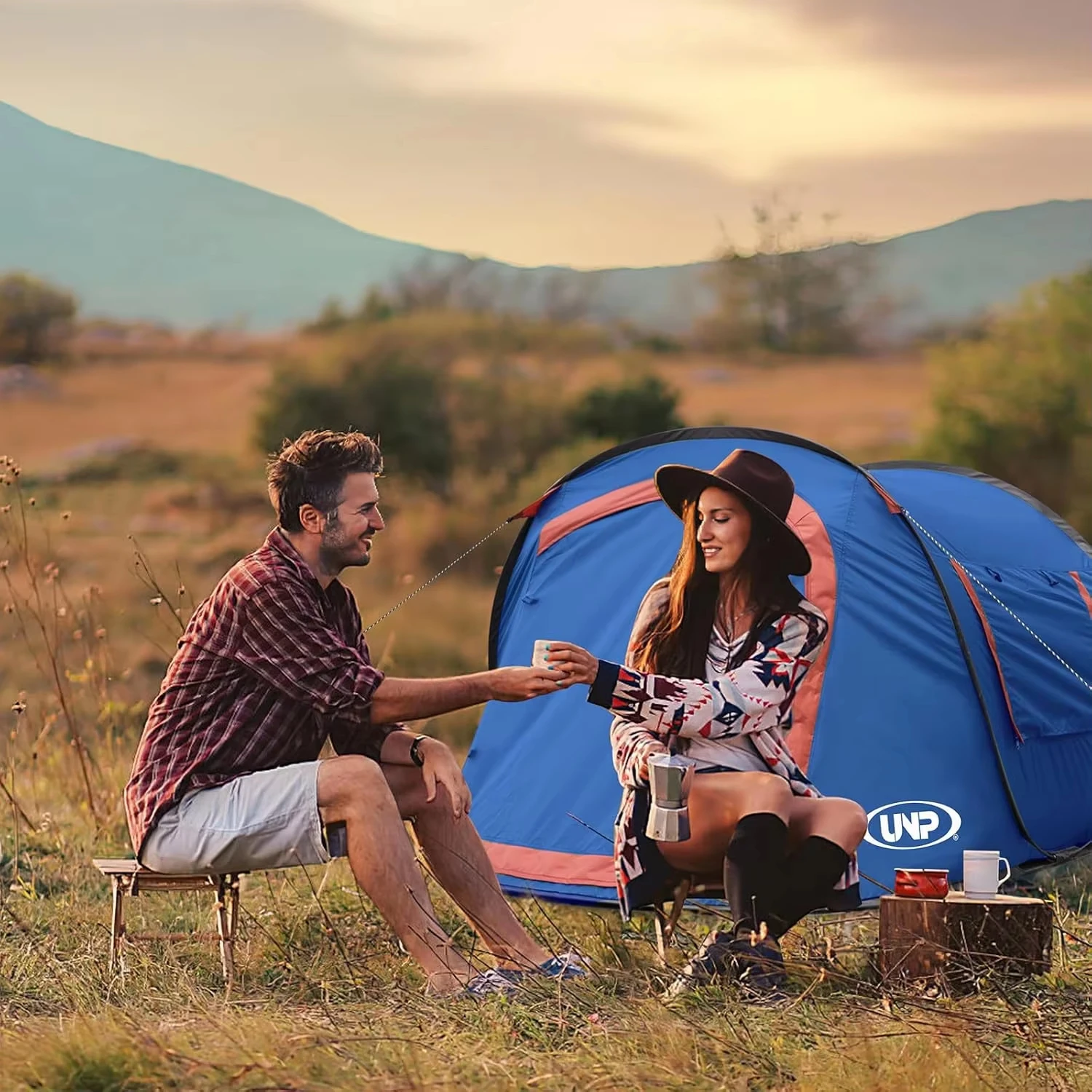
For those camping in variable conditions, ventilation adjustability allows fine-tuning the interior environment. In cold weather, vents can be partially closed to retain warmth while still managing necessary moisture release. In warm weather, maximizing ventilation creates a more comfortable sleeping environment.
The principles behind superior ventilation in dome tents represent significant engineering achievements that directly impact sleep quality and comfort. Proper ventilation not only keeps the interior feeling fresh but also prevents the uncomfortable experience of moisture dripping from tent walls onto sleeping bags and gear.
Cost-Effectiveness and Value Proposition
Two-person dome tents represent an excellent value proposition across various price points, with options available for nearly every budget:
- Budget models ($80-150): Basic functionality with simpler materials
- Mid-range models ($150-300): Balances quality materials with refined features
- Premium models ($300+): Optimized materials, advanced features, and enhanced durability
While initial purchase price is important, the true cost-effectiveness becomes apparent when considering cost-per-use over the tent’s lifetime. A quality $250 dome tent used for 50 nights over several years equates to just $5 per night—far less than other accommodation options.
Several factors influence where a specific tent falls within these price ranges:
– Pole material (aluminum commands premium over fiberglass)
– Fabric quality (higher denier and specialized treatments increase cost)
– Brand reputation and warranty coverage
– Additional features like vestibules, multiple doors, or specialized ventilation
– Manufacturing precision and attention to detail
The sweet spot for most recreational campers typically falls in the mid-range category, where tents offer reliable performance for typical conditions without specialized features that drive up costs. However, frequent campers or those facing challenging conditions often find the premium category delivers superior value through extended durability and enhanced functionality.
For those seeking optimal balance between quality and affordability, our collection of lightweight backpacking tents includes options at various price points, each delivering specific advantages based on intended use.
Who Benefits Most: Ideal Users for Two-Person Dome Tents
While two-person dome tents offer universal appeal, certain user profiles derive particular benefit from their unique combination of features:
Weekend Adventurers: These casual but frequent campers appreciate the balance between comfort and setup simplicity. The intuitive design means less time establishing camp and more time enjoying nature, while the durability handles occasional use throughout the year without deterioration during storage periods.
Backpacking Couples: Partners who share trail adventures find dome tents ideal for weight distribution between two packs. The space efficiency provides just enough room for two sleeping pads while keeping pack weight manageable for multi-day journeys.
Solo Campers with Gear: Individual campers who prioritize comfort and space for equipment find two-person dome tents offer the perfect compromise. The modest weight penalty compared to solo tents is offset by significantly increased living space and gear storage options.
Festival and Event Campers: Those using tents for music festivals or similar events benefit from the quick setup and breakdown, weather resistance if conditions turn poor, and sufficient space for two people plus essential items.
Beginner Campers: Those new to outdoor sleeping find dome tents particularly approachable. The intuitive setup reduces first-time frustration, while the stability forgives minor setup errors that might compromise other tent designs.
For hiking duos specifically, finding the right compact hiking shelters for two can dramatically enhance trail experiences through the right combination of protection, weight, and functionality.
Lightweight Backpacking Tent, Ultralight Backpacking Tent, Ultralight Bivy Tent
Ultralight Single Person Camping Tent with Aluminum Poles for 3-Season Backpacking Waterproof DesignPrice range: $94.88 through $326.82 Select options This product has multiple variants. The options may be chosen on the product pageTall / Stand Up Camping Tent, Two Room Camping Tent
$407.93 Select options This product has multiple variants. The options may be chosen on the product pageLightweight Backpacking Tent, Ultralight Backpacking Tent, Waterproof Backpacking Tent
$391.05 Select options This product has multiple variants. The options may be chosen on the product pageCompact Backpacking Tent, Lightweight Backpacking Tent, Waterproof Camping Tent
$335.52 Select options This product has multiple variants. The options may be chosen on the product pageUltralight Backpacking Tent, Ultralight Dome Tent, Winter Camping Tent
Price range: $369.63 through $370.07 Select options This product has multiple variants. The options may be chosen on the product pageCamping Tent with Vestibule, Waterproof Camping Tent
Price range: $407.89 through $479.48 Select options This product has multiple variants. The options may be chosen on the product page
Key Design Features That Maximize Performance
The exceptional performance of two-person dome tents stems from specific design elements that have been refined through decades of development:
Pole Structure: The classic crossing X-pole design creates the basic dome shape, while more advanced geodesic models add additional crossing points for enhanced stability. The number and arrangement of poles directly impact weather resistance, with more poles generally providing greater stability at the cost of increased weight.
Rainfly Coverage: Full-coverage rainflies extend nearly to the ground, maximizing weather protection, while partial-coverage designs reduce weight and enhance ventilation in mild conditions. The optimal design depends on intended use conditions, with alpine and stormy environments demanding fuller coverage.
Vestibule Design: The external covered storage area created by the rainfly extension provides valuable protected space without adding to the tent footprint. Single vestibule designs offer adequate storage for most users, while dual vestibule configurations provide dedicated space for each occupant—particularly valuable for extended trips requiring more gear.
Door Configuration: Single-door designs save weight but require one person to climb over the other for exits. Dual-door designs enhance livability for two people but add modest weight. The door size and orientation significantly impact ease of entry and exit.
Interior Organization: Thoughtfully placed mesh pockets, gear lofts, and hanging points transform limited interior space into a functional living environment by keeping essential items accessible and organized.
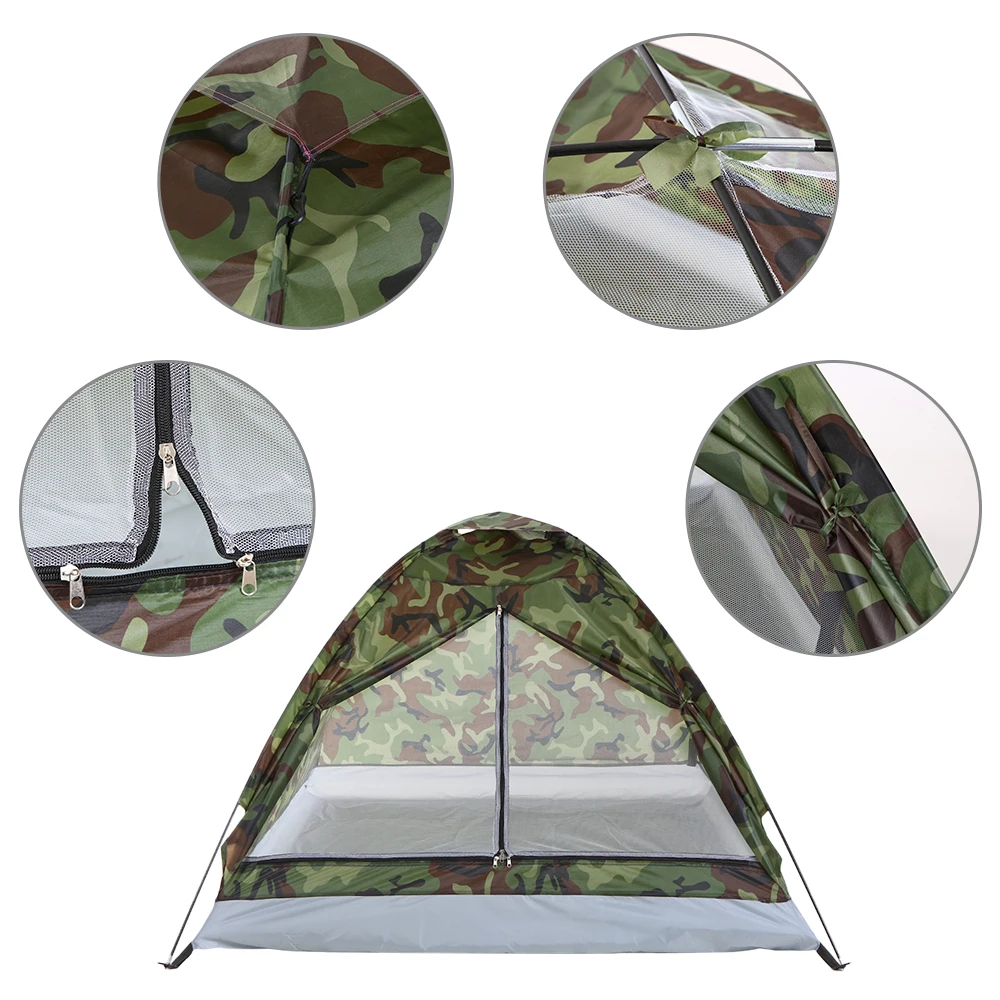
For those interested in maximizing functionality, our selection of backpacking tents with vestibules demonstrates how this specific feature enhances the overall tent experience through protected storage and transition space.
Is a Two-Person Dome Tent Right for Your Next Adventure?
To determine if a two-person dome tent matches your specific needs, consider the following factors:
Trip Duration: For weekend trips, the efficiency and quick setup of dome tents shine. For extended backcountry expeditions, their balance of space and weight becomes even more valuable.
Camping Environment: If you’ll face variable weather or challenging conditions, dome tents offer superior protection. For exclusively fair-weather camping, simpler alternatives might suffice.
Partner Situation: Will you consistently camp with a partner, occasionally share with someone, or primarily camp solo? Two-person domes offer flexibility across these scenarios.
Transport Method: If backpacking, weight becomes critical, pointing toward lighter dome models. For car camping, you might prioritize space and features over weight.
Setup Preferences: If you value simplicity and speed in establishing camp, dome tents offer significant advantages over more complex designs.
For those with specialized requirements or interests, exploring our recommendations for best 2-person tents can provide specific guidance based on your priority factors.
Additional Considerations for Maximum Tent Performance
To maximize your dome tent experience, keep these practical considerations in mind:
Site Selection: Choose a location that complements the tent’s strengths—look for naturally sheltered areas when possible, avoid depressions where water might collect, and clear the ground of sharp objects that could damage the floor.
Basic Maintenance: Extend your tent’s life through simple practices: never store it damp, clean dirt from zippers regularly, and repair small issues before they become major problems. When packing, fold rather than stuff the tent to minimize creasing that can degrade waterproof coatings.
Complementary Accessories: Consider a footprint (ground cloth) to protect the tent floor, additional guy lines for extreme conditions, and compression sacks to minimize packed size. These modest investments significantly enhance functionality.
Understanding tent waterproof ratings helps you match your tent’s capabilities to expected conditions, ensuring you’re adequately protected without carrying unnecessary weight.
By leveraging the inherent advantages of two-person dome tents and applying these practical considerations, you’ll maximize comfort and protection while enjoying the perfect balance of functionality that makes these shelters enduringly popular among campers worldwide.

